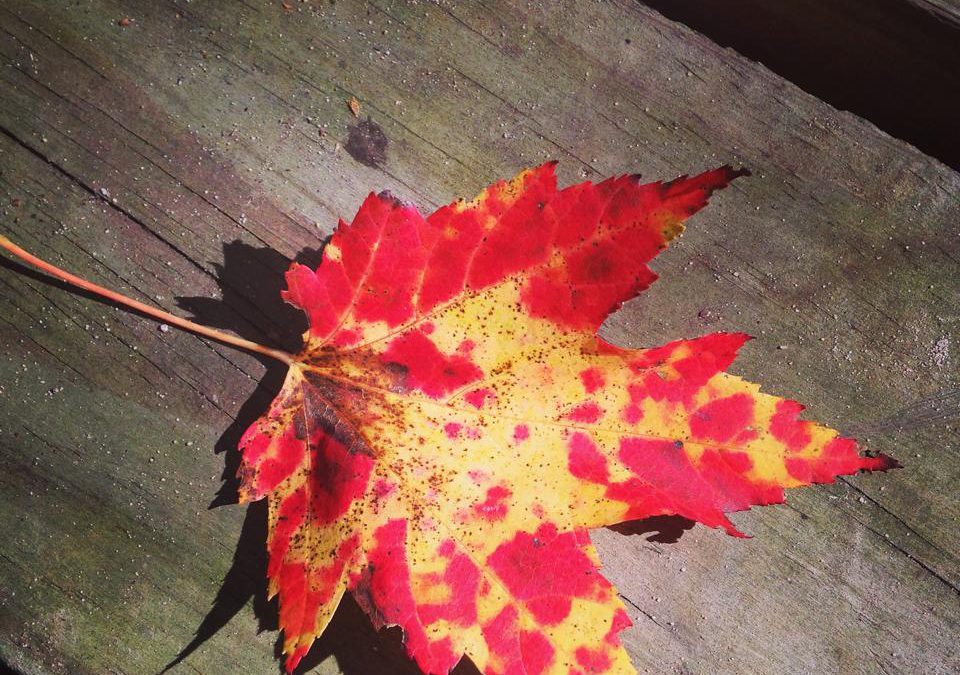
by Carrie Stevenson | Nov 18, 2020
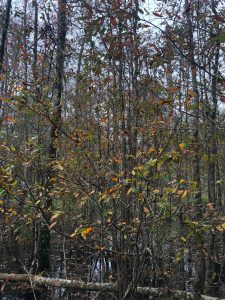
The blackgum/tupelo tree begins changing leaf color in early fall. Photo credit: Carrie Stevenson, UF IFAS Extension
Florida isn’t necessarily known for its vibrant fall foliage, but if you know where to look this time of year, you can find some amazing scenery. In late fall, the river swamps can yield beautiful fall leaf color. The shades are unique to species, too, so if you like learning to identify trees this is one of the best times of the year for it. Many of our riparian (river floodplain) areas are dominated by a handful of tree species that thrive in the moist soil of wetlands. Along freshwater creeks and rivers, these tend to be bald cypress, blackgum/tupelo, and red maple. Sweet bay magnolia (Magnolia virginiana) is also common, but its leaves stay green, with a silver-gray underside visible in the wind.
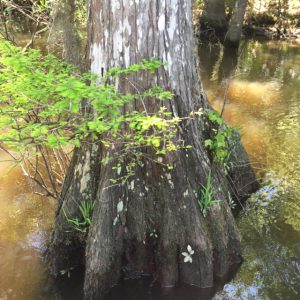
The classic “swamp tree” shape of a cypress tree is due to its buttressed trunk, an adaptation to living in wet soils. Photo credit: Carrie Stevenson, UF IFAS Extension
Bald cypress (Taxodium distichum) is one of the rare conifers that loses its leaves. In the fall, cypress tress will turn a bright rust color, dropping all their needles and leaving a skeletal, upright trunk. Blackgum/tupelo (Nyssa sylvatica) trees have nondescript, almost oval shaped leaves that will turn yellow, orange, red, and even deep purple, then slowly drop to the swamp floor. Blackgums and cypress trees share a characteristic adaptation to living in and near the water—wide, buttressed trunks. This classic “swamp” shape is a way for the trees to stabilize in the mucky, wet soil and moving water. Cypresses have the additional root support of “knees,” structures that grow from the roots and above the water to pull in oxygen and provide even more support.
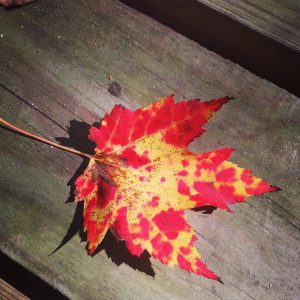
A red maple leaf displaying its incredible fall colors. Photo credit: Carrie Stevenson, UF IFAS Extension
The queen of native Florida fall foliage, however, is the red maple (Acer rubrum) . Recognizable by its palm-shaped leaves and bright red stem in the growing season, its fall color is remarkable. A blazing bright red, sometimes fading to pink, orange, or streaked yellow, these trees can jump out of the landscape from miles away. A common tree throughout the Appalachian mount range, it thrives in the wetter soils of Florida swamps.
To see these colors, there are numerous beautiful hiking, paddling, and camping locations nearby, particularly throughout Blackwater State Forest and the recreation areas of Eglin Air Force Base. But even if you’re not a hiker, the next time you drive across a bridge spanning a local creek or river, look downstream. I guarantee you’ll be able to see these three tree species in all their fall glory.
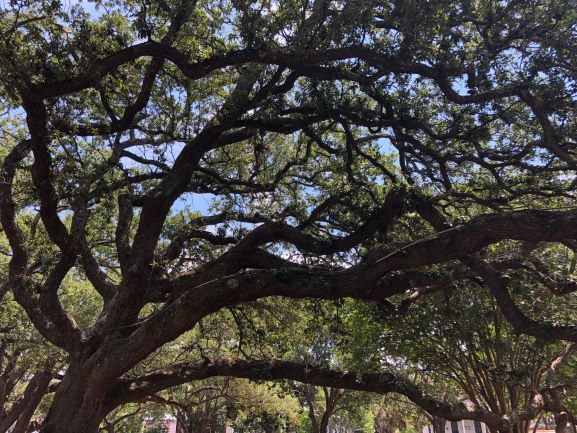
by Carrie Stevenson | Oct 21, 2020

Even healthy live oaks need maintenance and occasional trimming to stay safe. Photo credit: Carrie Stevenson, UF IFAS Extension
After storms, Extension agents are routinely asked about whose responsibility it is to maintain a tree along a property line. This becomes particularly important in a situation where a property owner’s tree or branch falls and causes damage to their neighbor’s home or possessions.
To clarify this often contentious issue, reference to legal experts is necessary. In a series of publications called “The Handbook of Florida Fence and Property Law,” two attorneys and a University of Florida law student explain several statutes that give us direction. The section on “Trees and Landowner Responsibility” goes into further detail and cites case-law, but for ease of reading it is summarized below.
Situation 1: Removing a healthy tree on a shared property line.
If two neighbors share a tree on their property line and one of them wants to remove it, the adjoining landowner must give their permission. Removing trees can impact property value, heating/cooling bills, or aesthetic value. Without a neighbor’s consent, the landowner cutting down a tree can be legally liable for damages.

Hurricanes can have serious impacts on trees in their path. Photo credit: Carrie Stevenson, UF IFAS Extension
Situation 2: Responsibility for overhanging branches and roots.
A big storm hits your neighborhood, with tons of rain, wind, and lightning. You wake up in the morning and see that a large branch fell from your neighbor’s tree and crushed your kids’ basketball goal. If branches from the neighbor’s tree were otherwise healthy, they are not responsible for any damages resulting from the tree. If it was dead, however, and their negligence contributed to the branch falling, they will be responsible for damages.
Keep in mind that if the neighbor’s tree/branches/roots are in good health but interfering with something in your yard, you may trim them at your own expense. The same goes for your tree hanging in their yard, so while it’s not required, it’s always good to have a conversation first to let them know your plans.
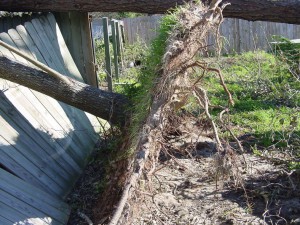
After Hurricane Ivan, this tree’s root system completely uprooted and destroyed and adjacent fence. Photo credit: Beth Bolles, UF IFAS Extension
Situation 3: Hurricane Sally blew your neighbor’s tree over and into your yard.
Just like the situation with branches and roots, the same principle goes for an entire tree falling on adjoining property—if the tree was alive, it’s the responsibility of the person whose yard it fell in. If it was dead when it fell, it’s the responsibility of the tree’s owner to pay for damages.
In a complicated situation involving property damage, the saying, “good fences make good neighbors” only goes so far. Be sure to note the health of your trees throughout the year and trim back dead or dying branches. If you see serious decay or have concerns about a tree’s health, contact your county Extension office or a certified arborist. Finally, if the circumstances aren’t easily determined, be sure to contact a licensed attorney and/or your insurance company for direction.
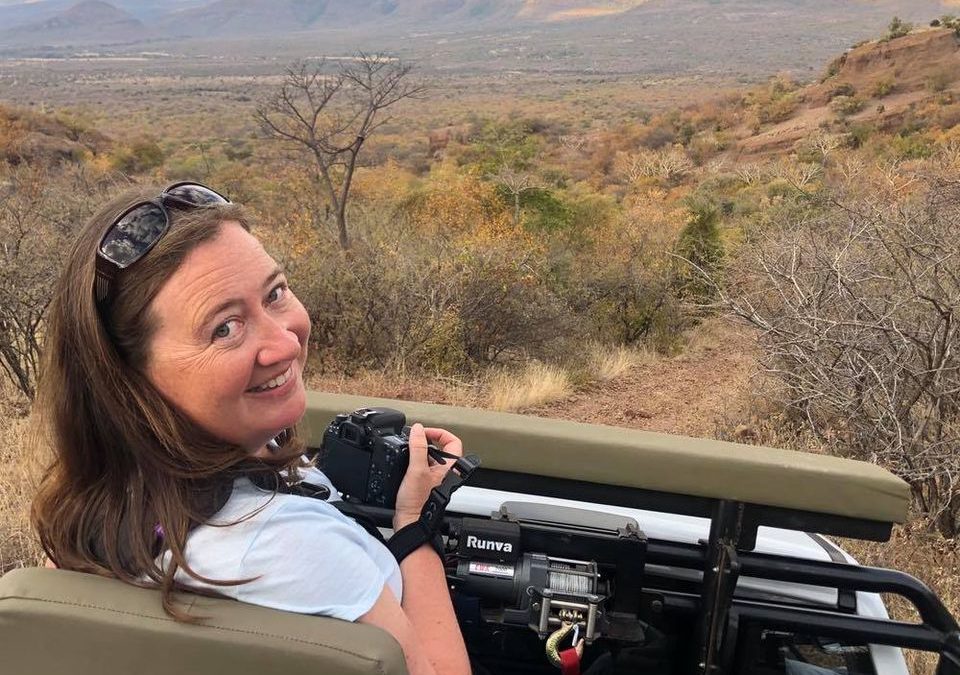
by Carrie Stevenson | Oct 7, 2020
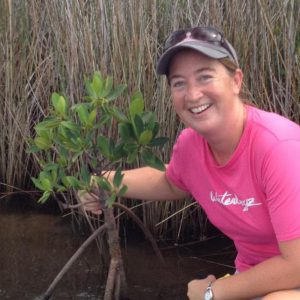 Carrie Stevenson is the Coastal Sustainability Agent for the UF/IFAS Escambia County Extension Office and has been with the organization almost 17 years. Her educational outreach programs focus on living sustainably within a vulnerable coastal ecosystem. She helps clientele better understand how to protect and preserve local landscape and water resources, wisely use our abundant rainfall and sunlight, and prepare and mitigate for flooding, coastal storms and climate impacts.
Carrie Stevenson is the Coastal Sustainability Agent for the UF/IFAS Escambia County Extension Office and has been with the organization almost 17 years. Her educational outreach programs focus on living sustainably within a vulnerable coastal ecosystem. She helps clientele better understand how to protect and preserve local landscape and water resources, wisely use our abundant rainfall and sunlight, and prepare and mitigate for flooding, coastal storms and climate impacts.
Growing up an avid reader and science junkie, a young Carrie aspired to find a career that allowed her to “be outdoors and wear jeans,” and in college sought to become a science writer. After graduation and a move to Pensacola, she found work as a field-based environmental specialist with the Florida Department of Environmental Protection (FDEP). While always more of an animal person than a plant person, her training with FDEP instilled a lifelong love of wetlands, as she spent her days tromping through the swamps, wet prairies, and creeks of northwest Florida. After joining UF IFAS Extension, she spent 6 years as a Florida Yards & Neighborhoods Agent before switching to Coastal Sustainability. Her expertise and articles focus on native plants, coastal habitats, wetlands, stormwater, and climate issues.
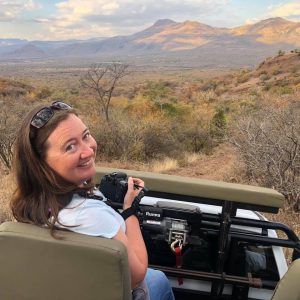 A native of Mississippi, Carrie has lived with her husband in Pensacola since 1999. Carrie earned her master’s degree in Biology/Coastal Zone Studies from the University of West Florida (Pensacola) and an undergraduate degree in Marine Science from Samford University (Birmingham, Alabama). A lifelong outdoors enthusiast, she enjoys biking, standup paddleboarding, and traveling to national parks with her family. She also has many favorite international outdoor experiences, ranging from hiking rainforests with an enthnobotanist in Belize to exploring the thorny scrub of South Africa. Carrie is the proud mom of an Eagle Scout and leads her daughter’s Girl Scout troop. She is a Fellow in the Natural Resources Leadership Institute (NRLI), past president of the Florida Association of Natural Resource Extension Professionals (FANREP), and member of IMPACT 100 Pensacola Bay.
A native of Mississippi, Carrie has lived with her husband in Pensacola since 1999. Carrie earned her master’s degree in Biology/Coastal Zone Studies from the University of West Florida (Pensacola) and an undergraduate degree in Marine Science from Samford University (Birmingham, Alabama). A lifelong outdoors enthusiast, she enjoys biking, standup paddleboarding, and traveling to national parks with her family. She also has many favorite international outdoor experiences, ranging from hiking rainforests with an enthnobotanist in Belize to exploring the thorny scrub of South Africa. Carrie is the proud mom of an Eagle Scout and leads her daughter’s Girl Scout troop. She is a Fellow in the Natural Resources Leadership Institute (NRLI), past president of the Florida Association of Natural Resource Extension Professionals (FANREP), and member of IMPACT 100 Pensacola Bay.
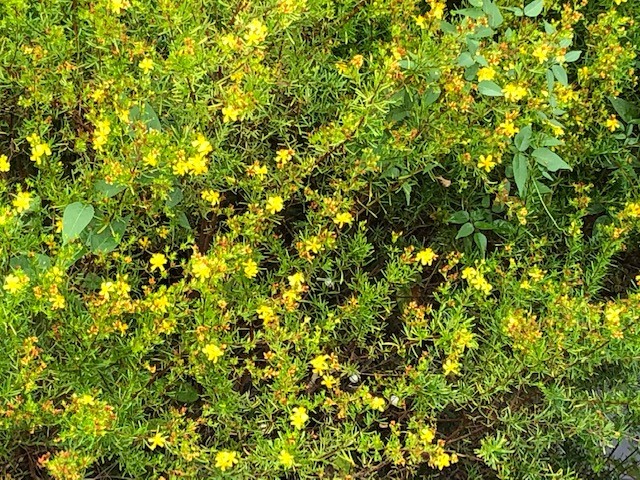
by Carrie Stevenson | Sep 28, 2020
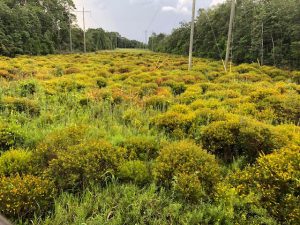
Large swaths of St. John’s Wort (Hypericum spp.) in bloom throughout the Blackwater River floodplain in Milton, Florida. Photo credit: Carrie Stevenson, UF IFAS Extension
Late summer is prime time for floating or canoeing down north Florida’s slow-moving, cold-water rivers. It is favorite summer tradition for our family, floating for hours in inner tubes and stopping to jump off rope swings.
If you drift down just about any north Florida river in the summer, you will likely notice large numbers of low-lying, thick green shrubs along the banks, loaded with tiny yellow flowers. These would be St. John’s wort. In our neck of the woods (or riverside), there are at least 28 species of Hypericum, with 9 of them endemic to the Panhandle. More devoted botanists can differentiate between all the species, but it takes years of study and field experience. All of them have woody stems with thin, evergreen, upright, opposite clusters of leaves, and small bright yellow flowers. Most prefer wet habitats—open marshes, streambanks, swamps, you name it—although 7 species are considered upland varieties. The most common species statewide is Marsh St. John’s Wort (Hypericum fasciculatum), which has softer-appearing leaves that remind me a lot of sand pine needles.
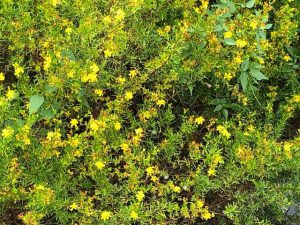
The bright yellow flowers of St. John’s Wort are noticeable throughout the summer in Panhandle wetlands. Photo credit: Carrie Stevenson, UF IFAS Extension
Named for the feast of St. John the Baptist (celebrated in late June, and the plant blooms in summer) and the Old English term for herb (wyrt), St. John’s Wort has long been notable for its medicinal purposes. Research has shown the plant to be particularly effective for treating symptoms of menopause and moderate depression. However, serious drug interactions can occur if taken with prescription medications, so it is imperative to speak with a physician or pharmacist before using St. John’s Wort.
St. John’s Wort also makes a great home landscape plant, as it is highly adaptable to many soil types and sunlight levels.
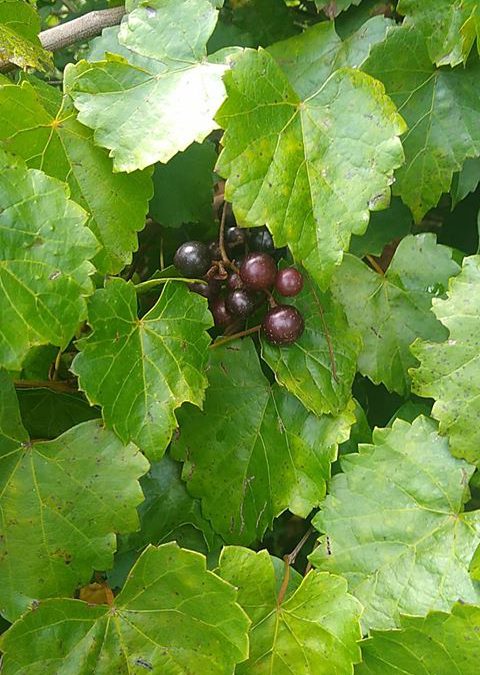
by Carrie Stevenson | Aug 14, 2020
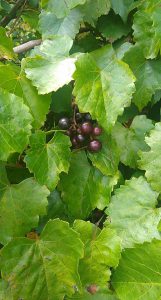
Tasty, edible muscadine grapes are ripening in northwest Florida now. Photo credit: Jennifer Shiver
There is something deeply satisfying about plucking fruit off a plant growing outside and tasting it right off the vine/bush/tree. Since childhood, I have reached carefully through the tiny and numerous thorns of blackberry bushes growing in the woods, hoping the berry I’d worked for was more sweet than tart. One vine-ripe fruit that never disappoints, however, is the native muscadine grape (Vitis rotundifolia). Granted, before eating for the first time you have to be aware that the thick skin will give way to a gelatinous goo with several seeds, but their refreshing taste on a hot summer day is unlike any other. Beloved by deer and other mammals and birds of all types, it’s hard to find a lot of muscadine grapes available in the woods because the wildlife has likely beaten you to them. You can find their unique leaves year-round, though, so at least you know where to look once the grapes start to form. I would be remiss if I didn’t mention these grapes also go by the term “scuppernong”, which is a colloquial term for the lighter green/bronze (and more common) muscadines in the southeast.

Muscadines are grown commercially for the wine industry throughout Florida.
While tasty on their own, muscadines are most prized for making jelly and wine. We used to have an older Southern Baptist deacon and neighbor who would slip us both, with a wink and an implied promise not to tell the preacher about the wine. Winemaking in Florida is an old tradition, and several local wineries specialize in these sweeter wines, like Chatauqua in DeFuniak Springs. They are often blended with other fruits like blueberry and strawberry. Our Extension colleagues with the Florida Agricultural and Mechanical University (FAMU) have a widely recognized viticulture program, and I recommend their resources if you are interested in growing muscadines yourself.
As for wild muscadines, you can find the vines all over the place, from shady forests to sunny beach dunes. The vines can be up to 100 feet long, climbing with the help of small tendrils. Inconspicuous greenish white flowers form in late spring, with fruit ripening in late summer/early fall. It serves you well to learn field identification for the muscadine, as it is a sweet treat on a hot Florida day.

















